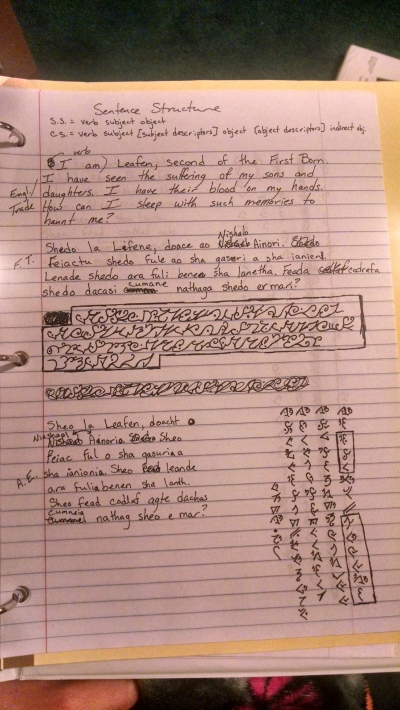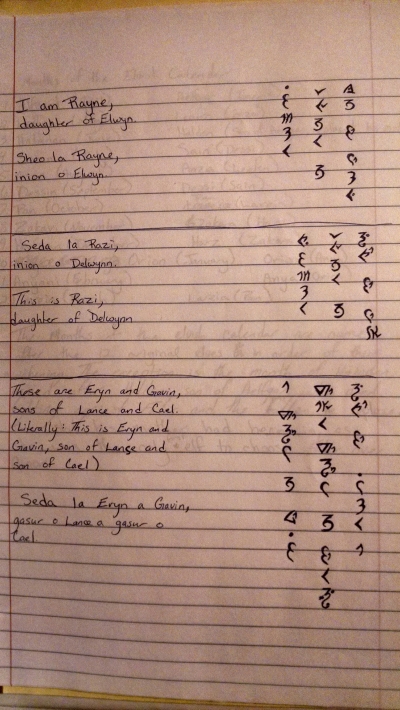
Hello! Hola! Dia duit! こんにちは! (Sorry. Couldn’t resist using my Japanese keyboard. 😉 )
Ever since I was a little kid, I have been fascinated by language and the variety of ways people can use to communicate with each other. I remember several times where my cousin and I would use random, made-up words to talk to each other, and our family would scold us because we “could be saying something bad in another, real-life language.” As far as my cousin and I were concerned, though, we were just talking. And even though the words were essentially meaningless, somehow, we knew what we were saying to each other.
Being a fan and writer of fantasy, the creation of language isn’t something new to me. Language creation seems to be a key element in the fantasy and sci-fi genres. Some of these languages are so complex and expansive that they literally have become real, utilized by their fan base as a means of legitimate communication. These languages range from Sindarin, one of the elvin languages in The Lord of the Rings, to Klingon in Star Trek, to Dovahzul from ESV: Skyrim. (Confession, my brother and I do actually text each other, and sometimes talk to each other, in Dovahzul).
Writers of fantasy and sci-fi, such as myself, LOVE to create new languages. Actually, it almost seems as if creating a new language is a pre-requisite for fantasy, what with how common it is. At least, that was how it seemed to me when I first started writing about the elves in my medieval fantasy series, Legend of the Stars. But I never really thought about all it took to create a language until much later, after I came across a list of most hated fantasy cliches. And, you guessed it, created languages were on the list. So why is it that languages like Sindarin and Dovahzul are so popular, and yet the fantasy community, as a whole, complains about invented languages? What makes one created language better than another?
I have been pondering that for a while, but within the last few years, as I’ve gone back to re-write my Legend of the Stars books and studied more languages on my own, I’ve started to understand the difference.
As I have said before, I am a lover of languages. While I wouldn’t claim to be fluent in anything other than English, (and sometimes even that is debatable), I have spent some time familiarizing myself with a variety of languages, including Spanish (I can understand far more than I can speak), Italian, German, Irish Gaelic, Hebrew, and Japanese, along with the fictional languages of Sindarin and Dovahzul. And, as I have become more familiar with other languages, I also am better able to understand what sets a good fictional language apart from a great one.
In both Sindarin and Dovahzul, I see a lot of similarities to real-life languages, unlike most fictional languages that are usually just a jumble of letters strung together in the hopes of creating a half-decent “word.” Sindarin, for instance, has a lot in common with Gaelic, both in spelling and pronunciation. Dovahzul has a nearly Aramaic feel to it, but the sentence structure seems to be closest to modern English, the word-creation is reminiscent of German, and the writing is a type of alphabetic cuneiform. Both of these languages follow relatively consistent rules and are easy enough to learn once you understand what those rules are.


While I can’t speak for the creators of Skyrim, I have done enough research on J.R.R. Tolkien (author of The Lord of the Rings, in case there’s someone who didn’t know that) to know that Tolkien was a language master. Tolkien knew roughly 16 languages, not including regular English: Ancient Greek, Latin, Goth, Old Norse (Old Icelandic), Swedish, Norwegian, Danish, Anglo-Saxon (Old English), Middle English, German, Dutch, French, Spanish, Italian, Welsh, and Finnish. It is said that Sindarin is a mixture of Welsh, Old English, and Old Norse. Tolkien was meticulous in his language creation, setting rules and following them in his creation of the languages in his books. I think that is probably why Sindarin still stands out as one of the foremost created languages in literary history.
It was this concept that I kept in mind when developing the elvin language in my own books. In my version of elvish, most of the words themselves are alterations of Irish Gaelic, Scottish Gaelic, and Germanic words. The writing system, depending on whether we’re talking about the ancient elvish or the modern elvish, was inspired by a mixture of Hebrew and Japanese (because those are the two languages I’m most familiar with outside of English). For instance, my ancient elvish (Druinel) writing system follows a Japanese sort of pattern: a syllabic “alphabet,” words that are not separated by spacing or notable punctuation, and sentences that are written top to bottom, right to left. Modern elvish follows an alphabetic structure, but vowels are represented primarily by tiny symbols added to consonant characters, much the same as in modern Hebrew. In both cases, proper nouns are “encased,” similar to Ancient Egyptian writing. The oldest elvish writing system in my series (Apex elvish) is more of a cursive script, however, utilizing a syllabary instead of an alphabetic structure and a writing system that more closely resembles either Arabic or Hindi.
The alphabet, though, is little more than a glossy finish, however, when it comes to creating a fictional language. The core of the language is actually the grammar and vocabulary, which is an entirely different issue all together. The key, I think, to creating a viable fictional language is whether or not you can create words and rules that are consistent enough for a person to actually understand and learn them. I think it’s this part of the language creation that is so difficult for me.
Confession: I am not a grammarian. My strength was never in grammar, unfortunately, so while vocabulary and alphabets seem to sink into my brain like water into a sponge, grammar often feels like it just hits my brain and bounces off again. As such, constructing an entire language, with all the little grammatical nuances that make it possible to create elaborate sentences that make sense, is extremely hard for me. And even when I put a structure together, I don’t always know what to call the different pieces. For example, the beginning of the Star Spell, which is partially quoted in The Four Stars, is constructed as follows:
(manner)(verb)(subject)(relation)(noun), (manner)
As did (the) Heroes of Ainor, likewise
Ava deamerune Geshe o Ainoru, avane
(verb)(verb)(subject)(direction)(i.o.)(d.o.)
do meld we in us (the) power
deameru aeaotha shine i shine cumacthe
(relation)(noun), (manner)(noun)(adj.)
of (the) Only/Greatest One, in union one,
o Aoneru Ni, i aeaothasu ni,
(verb)(d.o.)(location)(noun)(time)(verb)
to be light in darkness when wanes
la locran i deruni cethore basafe
(subject)(relation)(noun).
(the) hope of mortals.
drenasu o basafeni.
Complicated, right?
As I’ve worked on the languages for my stories, I’ve definitely noticed a trend toward English-esque sentence structure, so for the other languages in my stories I’ve really started to delve into different structural options. I must say, though, that in the end, I really have to admire people like Tolkien who can easily understand more than just the alphabet and the vocabulary. I think that, in time and with a fair amount of effort, I’ll be able to understand the grammar of the languages I have been learning, too. In the meantime, though, I’ll just keep pecking away at this whole language-creation business. Hopefully I won’t end up landing myself in the “worst cliche language attempts” instead.



